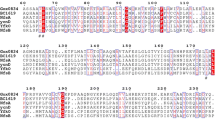Abstract
The NAD(P)H-nitroreductase of thePseudomonas sp. HK-6 which is capable of catabolizing 2,4,6-trinitrotoluene (TNT), was purified and biochemically characterized. The specific activity of the purified TNT nitroreductase was approximately 1.47 units/mg, and was concentrated to 10.1-fold compared to the crude extract. The optimal temperature and pH of the highest nitroreductase activity was 30°C and 7.5, respectively. The substrate specificity test revealed that the nitroreductase exhibited the highest enzyme activity for the TNT substrate of the nitroaromatic compounds tested in this study. Moreover, the molecular weight of the TNT nitroreductase was approximately 27 kDa on the SDS-PAGE. The N-terminal amino acid sequence of the purified protein was 5′-MDTVSLAKRRYTTKAYDASR, which is identical topnrB ofPseudomonas putida JLR11, and is capable of TNT reduction. The molecular analysis of the approximately 650-bp PCR product, orginating from the HK-6, revealed that the oxygen-insensitive NAD(P)H-nitroreductase gene, which transforms TNT in strain HK-6 with five unique amino acid sequences and diverges from the nitroreductases identified so far inPseudomonas, Burkholderia, andRalstonia, is frequently found amidst the powerful degraders of aromatic compounds.
Similar content being viewed by others
References
Robertson, B. K. and P. K. Jjemba (2005) Enhanced bioavailability of sorbed 2,4,6-trinitrotoluene (TNT) by a bacterial consortium.Chemosphere 58: 263–270.
Bryant, C. and M. DeLuca (1991) Purification and characterization of an oxygen-insensitive NAD(P)H-nitroreductase fromEnterobacter cloacae.J. Biol. Chem. 266: 4119–4125.
Kim, S. H., S. H. Song, and Y. J. Yoo (2006) Characterization of membrane-bound nitrate reductase from denitrifying bacteriaOchrobactrum anthropi SY509,Biotechnol. Bioprocess Eng. 11: 32–37.
McCormick, N. G., F. E. Feeherry, and H. S. Levinson (1976) Microbial transformation of 2,4,6-trinitrotoluene and other nitroaromatic compounds.Appl. Environ. Microbiol. 31: 949–958.
Vorbeck, C., H. Lenke, P. Fischer, J. C. Spain, and H. J. Knackmuss (1988) Initial reductive reactions in aerobic microbial metabolism of 2,4,6-trinitrotoluene.Appl. Environ. Microbiol. 64: 246–252.
Fiorella, P. D. and J. C. Spain (1997) Transformation of 2,4,6-trinitrotoluene byPseudomonas pseudoalcaligenes JS52.Appl. Environ. Microbiol. 63: 2007–2015.
Chang, H. W., H. Y. Kahng, S. I. Kim, J. W. Chun, and K. H. Oh (2004) Characterization ofPseudomonas sp. HK-6 cells responding to explosive RDX (hexahydro-1,3,5-trinitro-1,3,5-triazine).Appl. Microbiol. Biotechnol. 65: 323–329.
Haidour, A. and J. L. Ramos (1996) Identification of products resulting from the biological reduction of 2,4,6-trinitrotoluene, 2,4-dinitrotoluene and 2,6-dinitrotoluene byPseudomonas sp.Environ. Sci. Technol. 30: 2365–2370.
Riefler, R. G. and B. F. Smets (2000) Enzymatic reduction of 2,4,6-trinitrotoluence and related nitroarenes: Kinetics linked to one-electron redox potentials.Environ. Sci. Technol. 34: 3900–3906.
Oh, B. T., G. Sarath, and P. J. Shea (2001) TNT nitroreductase from aPseudomonas aeruginosa strain isolated from TNT-contaminated soil.Soil Biol. Biochem. 33: 875–881.
Haynes, C. A., R. L. Koder, A. F. Miller, and D. W. Rodgers (2002) Structure of nitroreductase in three states.J. Biol. Chem. 277: 11513–11520.
Wang, C. J., S. Thiele, and J. M. Bollag (2002) Interaction of 2,4,6-trinitrotoluene (TNT) and 4-amino-2,6-dinitrotoluene with humic monomers in the presence of oxidative enzymes.Arch. Environ. Contam. Toxicol. 42: 1–8.
Perez-Reinado, E., R. Blasco, F. Castillo, C. Moreno-Vivian, and M. D. Roldan (2005) Regulation and characterization of two nitroreductase genes,nprA andmprB, ofRhodobacter capsulatus.Appl. Environ. Microbiol. 71: 7643–7649.
Peterson, F. J., R. P. Mason, J. Hovsepian, and J. L. Holtzman (1979) Oxygen-sensitive and-insensitive nitroreduction byEscherichia coli and rat hepatic microsomes.J. Biol. Chem. 254: 4009–4014.
Watanabe, M., T. Nishino, K. Takio, T. Sofuni, and T. Nohmi (1998) Purification and characterization of wildtype and mutant “classical” nitroreductase ofSalmonella typhimurium. L33R mutation greatly diminishes binding of FMN to the nitroreductase ofS. typhimurium.J. Biol. Chem. 273: 23922–23928.
Nivinskas, H., R. L. Koder, Z. Anusevicius, J. Sarlauskas, A. F. Miller, and N. Cenas (2001) Quantitative structure-activity relationships in two-electron reduction of nitroaromatic compounds byEnterobacter cloacae NAD(P)H: nitroreductase.Arch. Biochem. Biophys. 385: 170–178.
Nokhbeh, M. R., S. Boroumandi, N. Pokorny, P. Koziarz, E. S. Paterson, and I. B. Lambert (2002) Identification and characterization of SnrA, an inducible oxygen-insensitive nitroreductase inSalmonella enterica serovar Typhimurium TA1535.Mutat. Res. 508: 59–70.
Rafii, F., R. Wynne, T. M. Heinze, and D. D. Paine (2003) Mechanism of metronidazole-resistance by isolates of nitroreductase-producingEnterococcus gallinarum andEnterococcus casseliflavus from the human intestinal tract.FEMS Microbiol. Lett. 225: 195–200.
Caballero, A., J. J. Lazaro, J. L. Ramos, and A. Esteve-Nunez (2005) PnrA, a new nitroreductase-family enzyme in the TNT-degrading strainPseudomonas putida JLR11.Environ. Microbiol. 7: 1211–1219.
Bradford, M. M. (1976) A rapid and sensitive method for the quantitation of microgram quantities of protein utilizing the principle of protein-dye binding.Anal. Biochem. 72: 248–254.
Kim, H. G., Y. Kim, H. M. Lim, H. J. Shin, and S. W. Kim (2006) Purification, characterization, and cloning of trimethylamine dehydrogenase fromMethylophaga sp. strain SKI.Biotechnol. Bioprocess Eng. 11: 337–343.
French, C. E., S. Nicklin, and N. C. Bruce (1998) Aerobic degradation of 2,4,6-trinitrotoluene byEnterobacter cloacae PB2 and by pentaerythritol tetranitrate reductase.Appl. Environ. Microbiol. 64: 2864–2868.
Bollag, D. M., M. D. Rozycki, and S. J. Edelstein (1996)Protein Method. 2nd ed., Wiley-Liss, Inc., New York, NY, USA.
Yoon, Y. C., H. J. Park, N. K. Lee, and H. D. Paik (2005) Characterization and enhanced production of enterocin HJ35 byEnterococcus faecium HJ35 isolated from human skin.Biotechnol. Bioprocess Eng. 10: 296–303.
Yun, S. H., C. Y. Yun, and S. I. Kim (2004) Characterization of protocatechuate 4,5-dioxygenase induced fromp-hydroxybenzoate-culturedPseudomonas sp. K82.J. Microbiol. 42: 152–155.
Kahng, H. Y. (2002) Cellular responses ofPseudomonas sp. KK1 to two-ring polycyclic aromatic hydrocarbon, naphthalene.J. Microbiol. 40: 38–42.
Blasco, R. and F. Castillo (1993) Characterization of a nitrophenol reductase from the phototrophic bacteriumRhodobacter capsulatus E1F1.Appl. Environ. Microbiol. 59: 1774–1778.
Rau, J. and A. Stolz (2003) Oxygen-insensitive nitroreductases NfsA and NfsB ofEscherichia coli function under anaerobic conditions as lawsone-dependent azo reductases.Appl. Environ. Microbiol. 69: 3448–3455.
Author information
Authors and Affiliations
Corresponding author
Rights and permissions
About this article
Cite this article
Kahng, HY., Lee, BU., Cho, YS. et al. Purification and characterization of the NAD(P)H-nitroreductase for the catabolism of 2,4,6-trinitrotoluene (TNT) inPseudomonas sp. HK-6. Biotechnol. Bioprocess Eng. 12, 433–440 (2007). https://doi.org/10.1007/BF02931067
Received:
Accepted:
Issue Date:
DOI: https://doi.org/10.1007/BF02931067




